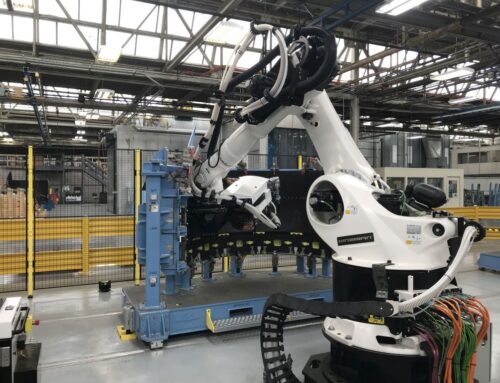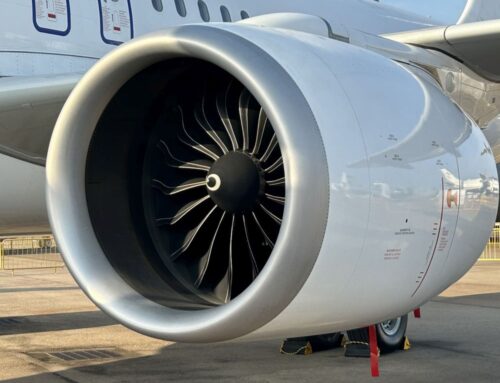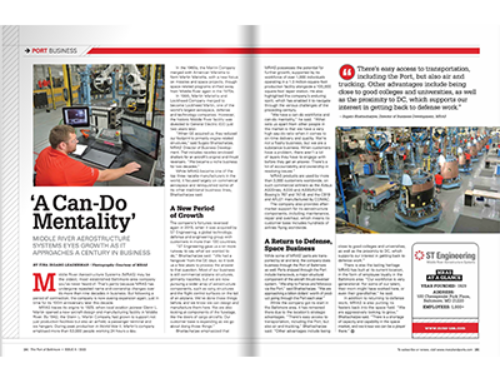Middle River Aircraft Systems celebrates 20 years of success with GE Aviation
November 21, 2017

The B-57A Canberra tactical bomber, which also was used as a reconnaissance aircraft, was built at Middle River for the U.S. Air Force by the Glenn L. Martin Company.
Middle River Aircraft Systems (MRAS) this month is marking two decades under GE ownership, which has seen this operation develop world-class capabilities in jet engine nacelles, along with composites for application in propulsion systems and aerostructures.
The facility that is home to MRAS today traces its origins to 1929, when aviation pioneer, aircraft designer and manufacturer Glenn L. Martin moved his rapidly-growing corporation from Cleveland Ohio to Middle River, situated northeast of Baltimore, Maryland. Access to water, rail, road, and proximity to the nation’s capital in Washington, D.C. were key factors behind the move – placing the facility adjacent to what is now named Martin State Airport.
During his career, Martin designed more than 85 different aircraft (totaling 11,000 units built) and employed more than 53,000 people during the peak of World War II.
Production of iconic Martin aircraft, and the transition to GE ownership
The Middle River factory assembled some of Martin’s iconic aircraft, notably the M-130 flying boat for Pan American Airways during the 1930s (including the famous China Clipper); and the PBM Mariner, a flying boat patrol bomber of World War II that performed anti-submarine missions and surveillance in the Atlantic and Pacific Oceans. The jet-powered B-57 Canberra – a tactical bomber that also served as a reconnaissance aircraft – also was produced at Middle River.

This machine, used for high-speed drilling of hundreds of thousands of holes as acoustic treatment in nacelles, is among MRAS’ investment in new production resources.
Through subsequent mergers, the Middle River business evolved with its ownership by Martin Marietta (1961) and Lockheed Martin (1995). In November 1997, Lockheed Martin announced the historic Middle River factory’s sale to General Electric.
While this transaction ended nearly 70 years of Martin Aviation heritage at Middle River, it opened a new chapter as a wholly owned subsidiary under GE – called Middle River Aircraft Systems. Today, the facility is part of GE Aviation’s Assembly and Test Value Stream, employing more than 660 persons. It specializes in composite technology, engine nacelles, thrust reversers and aerostructures for commercial and military applications.
Over 10,000 thrust reversers for jet engines on various aircraft have been built by the business since 1970 – the year it began producing this type of system. Benefitting from the resources of GE Aviation, significant investment has been made during the past several years in tools, machinery and methods, upgrading Middle River Aircraft Systems’ production and test capabilities, along with its overall competitiveness.
MRAS’ industrial role for business jet and airliner nacelle systems
One of the longest-serving MRAS-produced jet engine thrust reversers is for GE Aviation’s CF6 engine, which powers such jetliners as Boeing’s 767 and the Airbus A330, as well as the Kawasaki C-2 military airlifter.
MRAS’ thrust reversers are in widespread use on GE Aviation CF34 turbofan engines that equip E190/E195 regional aircraft from Brazil’s Embraer and are now entering service with a new market entrant: the COMAC ARJ21, one of China’s first jetliners built to international civil aviation regulatory standards.
One of first thrust reversers for jetliners made almost entirely from composite materials is the MRAS-designed and produced system for Pratt & Whitney’s PW4168 engine – developed specifically for the Airbus A330. MRAS’ composites expertise also is applied to the thrust reverser it produces for GE Aviation’s GEnx engine, used on Boeing 747-8 jetliners.
The Nexcelle joint venture with France’s Safran Nacelle
An important milestone for MRAS was the creation of Nexcelle, a joint venture with fellow parent company Aircelle (now Safran Nacelles) announced in 2008, to develop jet engine nacelles for new-generation integrated propulsion systems. MRAS plays an important role in Nexcelle’s two program wins: GE Aviation’s Passport engine that powers the Bombardier 7000 business jet; and the CFM International LEAP-1C powerplant for the Chinese COMAC C919 jetliner.

The fan cowl assembly’s large upper and lower doors for the Bombardier 7000 business jet’s nacelle system are manufactured by Middle River Aircraft Systems with composite material for lower weight.
The fan cowl assembly’s large upper and lower doors for the Bombardier 7000 business jet’s nacelle system are manufactured by Middle River Aircraft Systems with composite material for lower weight. Based on Nexcelle’s work-sharing relationship, Middle River Aircraft Systems has the lead industrial role for the Passport nacelle system, and supplies such key elements as the inlet (optimized for reduced aerodynamic drag), as well as the inner barrel and large fan cowl assembly (produced with the extensive use of composites for lighter weight).
For the LEAP-1C’s nacelle system, MRAS has the responsibility for components that include the integrated inlet and fan cowls, the thrust reverser’s forward and aft inner fixed structure, as well as the engine mounts. The company’s expertise applied on the LEAP-1C ranges from composite and metal bondments to internal acoustic treatment.
Building on the Nexcelle joint venture relationship, Middle River Aircraft Systems marked a significant win in 2011 when it was selected by Safran Nacelles to supply the thrust reverser system and engine build-up (EBU) for the LEAP-1A powerplant on Airbus’ A320neo. Safran Nacelles has the nacelle system prime contractor responsibility to Airbus on the LEAP-1A-powered A320neo – a jetliner program that involves one of the aviation industry’s most rapid production ramp-ups ever, placing MRAS at the forefront of this industrial endeavor.
With its demonstrated nacelle system expertise, MRAS looks to the future with confidence in carrying out its current production programs and looks to secure new opportunities in the coming years.




